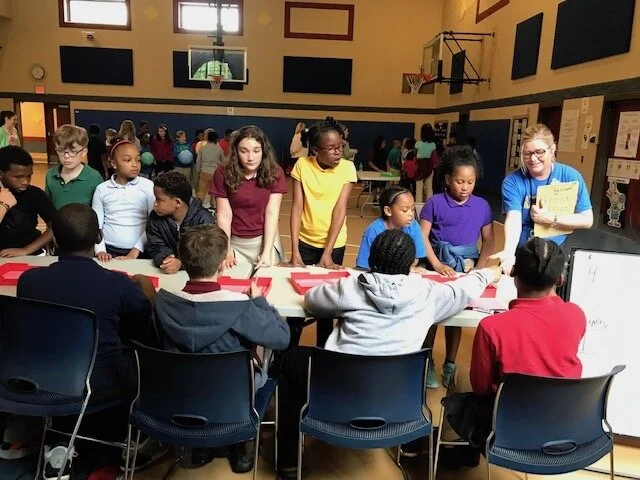Students as Teachers Dig into Science Standards
“I want students to realize that learning can be fun. It’s not just about what’s in the book or what’s on the test. It’s about becoming lifelong inquirers who use their skills for the good of others.”
-Charlene Tabata
King Community Learning Center, Akron
Charlene Tabata’s 5th grade students create hands-on experiments to teach scientific strategies to younger peers.
by Charlene Tabata
For the 2018-2019 school year, I was the recipient of the Master Teacher Award from the Martha Holden Jennings Foundation. Winning this award afforded me the opportunity to use its $7500 grant to fund Project StRIPE (Student Run Interactive Problems and Experiments). Project StRIPE is an interactive, culminating event of a year-long project based learning (PBL) experience for the 5th grade students.
During the first year, through IB (International Baccalaureate®) units, fifth grade students engaged in ongoing experimentation based on key content standards, including activities from the Cleveland Museum of Natural History’s Science-to-Go program.
Based on these activities, teams of fifth grade students then created multidisciplinary, hands-on experiments and activities to share their new learnings and teach scientific strategies to younger peers. My students then collaborated with teachers from all grade levels to determine what items would be the best to purchase with money from the grant. Various materials were purchased to help students teach skills in their stations. Every decision, from the minutest detail, such as what color marker to use, to the ‘big concepts’ of how to differentiate among the grade levels, was decided by the fifth grade teams.
Over two days in May, every student in our school, grades K-5, rotated through my 5th grade students’ stations. My students became the teachers, responsible for set-up, teaching, and take-down. The fifth grade student instructors took time to reflect after the first few rotations and made changes to make the program more efficient and accessible to all. Students and teachers debriefed following the StRIPE days. Feedback from my fellow teachers included comments such as, “This was a great activity to show mentorship to the younger students,” and, “Having the stations run by students helped my students to be more engaged in the activities.” One of the second grade students said, "I can't wait until 5th grade so I can be the teacher too.” The IB Coordinator remarked that, “Students were agents of their own learning.” Our current 5th graders, who were participants last year, have also said many times they are very excited to be the teacher leaders this year. Parents commented on the positive influence of the older students and the meaningful activities provided for the students.
In this second year, we have continued to use the materials throughout the year to enhance our hands-on experiments as we dig deeper into science standards and apply knowledge they’ve learned through their written lessons. Many students commented on how having the hands-on experience helped ‘bring to life’ the concepts that they’d read about previously. Students have taken notes and have kept track of various experiments they’ve done for use in this year’s StRIPE Day activities. They’ve also discussed ways to alter the experiments to increase the variety, in hopes of engaging students this year.
“Project StRIPE was, and will continue to be, a strong component of our school’s collaboration and desire to develop strong student leadership.”




